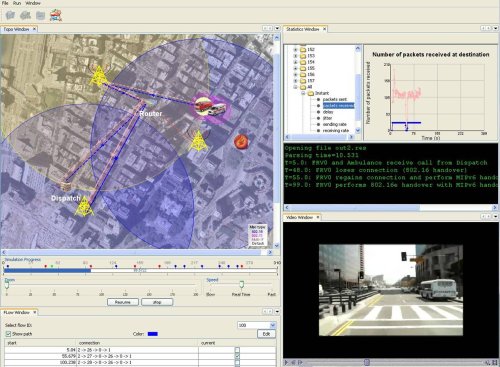Seamless and Secure Mobility
There is a wide variety of disjoint network types for example, Wi-Fi, WiMAX, Bluetooth, ZigBee and cellular networks (2.5G, 3G, 4G). However, most implementations are developed for single vendor platforms and do not allow for equipment interoperability. Key obstacles to seamless mobility include:
- Lack of scalability: roaming is available between a limited set of networks and operators.
- Lack of standard handover interfaces: no interoperability between different vendor equipment.
- Limited QoS guarantees during handover: during a handover there is an important disruption to user traffic: significant latency, high signaling messages overhead and processing time, significant resources and routes setup delay, high handover failures and packet loss rate.
- No security: it is hard to maintain the same (if any) level of security when roaming across different access networks.
Technical Approach
Our technical approach consists of considering complex protocol interactions and cross-layer techniques and the use of advanced measurement in order to accurately assess and manage the performance and security characteristics of mobility protocols.

Cross-layer protocol interactions
This work supports the IEEE 802.21 working group on Media Independent Handovers (MIH). After participating in the group's activities for over two years, we completed edits to the IEEE 802.21 draft specification as part of final sponsor letter balloting. The draft was published as a standard in January, 2009.
In addition, we evaluated mobility protocols' interactions across network layers 1-4 and the use of media independent handover functionality. As part of this work, we developed NS-2 models of IEEE 802.21 MIH architecture components such as the Event, Command, and Information Services, and transport of Layer 2 trigger information to higher layers. We also produced a set of NS-2 models of MAC-layers such as IEEE 802.16 and IEEE 802.11 that we used with the MIH functions to model vertical, i.e. heterogeneous, handovers that are assisted by cross-layer information passage.
IP mobility support
In this effort we are developing analytical and simulation tools and models in order to evaluate the performance of different IP mobility protocols and some of their extensions currently being considered at the IETF. Since cross-layer protocol interactions are key to achieving seamless and secure mobility, much attention is devoted to developing effective measurement techniques for capturing and characterizing these interactions. Similarly, abstraction models for the radio propagation, PHY, MAC, IP, and TCP layers are designed in order to accelerate the development and evaluation of mobility protocols. These models are validated against laboratory experimentation and prototype implementations.
Secure mobility
There are several factors that affect the implementation of security mechanisms and how they are characterized and measured in different types of networks. Our efforts in this area are aimed at:
- understanding the security implications posed by seamless mobility, and
- developing possible ways for expediting the authentication process while maintaining the level of protection during a heterogeneous handover.
In this context we are developing models to evaluate fast authentication schemes including re-authentication and pre-pre-authentication based on a common authentication framework such as the Extensible Authentication Protocol (EAP).
Mobility information services
Information services are key to achieving timely handovers and seamless mobility. We are investigating potential information service architectures and methods for accessing and distributing secure mobility information. We are developing measurement techniques and models for characterizing performance trade-offs.
Contributions to Standards Developing Organizations
| ---- IETF ---- | |||
| Date | Name | Format | |
| July 2007 | Performance Evaluation of L3 MIH Transport | ppt | |
| ---- IEEE 802.11 ---- | |||
| Date | Name | Format | |
| November 2006 | Proposal-selected-psuedo-code-in-lb88 | doc | |
| ---- IEEE 802.19 ---- | |||
| Date | Name | Format | |
| January 2007 | Organizing Matrix for Coexistence | doc | |
| ---- IEEE 802.21 ---- | |||
| Date | Name | Format | |
| September 2005 | Parameter_Effects_on_Performance | doc | |
| January 2006 | Performance measurements for Link Going Down Trigger | ppt | |
| March 2006 | 802_16_Parameter_Effects_on_Handover_Performance | ppt | |
| May 2006 | QoS Proposal | doc | |
| May 2006 | MIH_Handover_scenarios | ppt | |
| July 2006 | QoS support | ppt | |
| January 2007 | QoS Updates | doc | |
| May 2007 | Transport Protocol and State Machine | ppt | |
| July 2007 | Performance Evaluation of L3 MIH Transport | ppt | |
Technical Developments
ANTD assists in the completion of the IEEE 802.21 Media Independent Handovers (MIH) draft
The IEEE 802.21 was published on January 21, 2009. This is the final realization of a multi-year project to standardize a media independent handover protocol. The scope of this new standard is to define mechanisms that enable optimized handovers between heterogeneous networks such as IEEE 802 and cellular networks. NIST staff played an important role in the standard development process by providing key technical contributions and quantitative evaluations for several proposals considered by the working group. Furthermore, David Cypher from NIST assumed the role of technical editor of the specifications. NIST continues its efforts towards the development of secure and scalable network mobility services by participating in the IEEE 802.21 security task group and in the Internet Engineering Task Force. The publication of the IEEE 802.21 standard specifications coincides with the final approval of an Internet Engineering Task Force co-authored by Nada Golmie from NIST on transporting the IEEE 802.21 information within an IP network.
Associated Product
Simulation models for IEEE 802.16 and mobility extensions to NS-2
Selected Publications
Timely Effective Handover Mechanism in Heterogeneous Wireless Networks
Performance Metrics for IEEE 802.21 Media Independent Handover (MIH) Signaling
Contacts
-
(301) 975-3387

